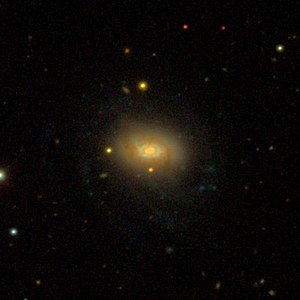NGC 5145
| Galaxy NGC 5145 |
|
|---|---|

|
|
| SDSS | |
| AladinLite | |
| Constellation | Hunting dogs |
|
Position equinox : J2000.0 , epoch : J2000.0 |
|
| Right ascension | 13 h 25 m 13.9 s |
| declination | + 43 ° 16 ′ 02 ″ |
| Appearance | |
| Morphological type | S? / HII / Sbrst |
| Brightness (visual) | 12.6 mag |
| Brightness (B-band) | 13.4 mag |
| Angular expansion | 2.0 ′ × 1.8 ′ |
| Position angle | 90 ° |
| Surface brightness | 13.8 mag / arcmin² |
| Physical data | |
| Redshift | 0.004086 ± 0.000037 |
| Radial velocity | 1225 ± 11 km / s |
|
Stroke distance v rad / H 0 |
(58 ± 4) · 10 6 ly (17.8 ± 1.3) Mpc |
| history | |
| discovery | Wilhelm Herschel |
| Discovery date | April 9, 1787 |
| Catalog names | |
| NGC 5145 • UGC 8439 • PGC 46934 • CGCG 218-010 • MCG + 07-28-009 • IRAS 13230 + 4331 • 2MASX J13251390 + 4316018 • GC 3537 • H II 667 • h 1602 • USGC U532 NED01 | |
NGC 5145 is a 12.6 likes bright spiral starburst galaxy with extensive star formation from Hubble type Sb in the constellation Canes Venatici on the northern sky . It is estimated to be 58 million light years away from the Milky Way and has a diameter of about 35,000 ly.
In the same area of the sky there is a. a. the galaxy NGC 5123 .
The object was discovered on April 9, 1787 by Wilhelm Herschel with an 18.7-inch reflector telescope, who described it as "pB, vS, lE, bM".
